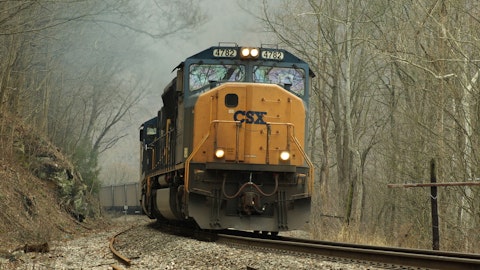Justin Long: Great. I appreciate all that detail. Thanks for the time.
John Olin: Thank you, Justin.
Operator: The next question comes from Scott Group with Wolfe Research. Please go ahead.
Scott Group: Hey, thanks. Good morning guys. So any color on the new Tier 4 local orders, is that one rail or multiple rails, and can you say who it’s with and how you expect that order to be split out over the next couple of years? And then just maybe just separately, as I think about like markets, any update here on ECP breaks, it’s in the news a little bit, how you think about that opportunity?
Rafael Santana: Scott, I think first, I mean, we are continuing to see our demand for both new locomotives and for modernizations as we had highlighted on previous calls. So we’ve been able to secure at this point, over 100 units. They will be delivered between 2023 and 2024 and it’s really a function of us working through the supply chain here, but that’s how we see it playing out. And we continue to look at certainly, I think, expanding some of the penetration of some of the products that we have. I think specifically with brakes that’s something we talked earlier on during — when we started the integration. So it’s something we’re certainly looking at incorporating the new products, and it’s certainly an opportunity that we’ll continue to look at it.
Scott Group: Okay. And then as I think about last year and now your guidance for this year, right, better revenue growth is sort of coinciding with maybe some margin pressure and I know sort of when revenue growth slows, some better margins. Is there something we can do to sort of get both at the same time of good revenue growth and margin improvement sort of coinciding with each other, I’m just curious how you think about that over the next few years?
Rafael Santana: Well, I’ll just start with, I think we’re well positioned to both revenue and margin expansion going to 2023. I think what gives us, I’ll call greater confidence than maybe before even is the fact that we have the backlog coverage that goes not just into 2023, I think you saw some of my comments when it comes down to visibility into 2024 and 2025. So we believe our guidance here is pretty prudent in the light of all the headwinds we had in the past couple of years. So we feel pretty really committed to be driving here strong mid-single digits up on the revenue line and double digits on EPS.
Scott Group: Okay, thank you guys.
Operator: The next question comes from Chris Wetherbee with Citigroup. Please go ahead.
Unidentified Analyst: Hey, good morning. This is Matt on for Chris. Thanks so much for taking the question. If you guys could just touch a little bit more on how you’re evaluating acquisition opportunities and sort of how we should be thinking about the year in 2023 and if you think sort of in 2022, if there is any comparable metrics on that front, just sort of show your puts and takes on how you’re thinking about that moving forward into this year?
John Olin: Hi Matt, this is John. Matt, just in general, when we look at capital allocation, we are very interested in doing strong strategic bolt-on M&A that is accretive to overall margins. So that being said, first, if we don’t have that, we’re very, very happy to return the cash to our shareholders in the form of share repurchases. And that’s exactly what you saw in 2022. We had on three acquisitions totaling about $90 million of investment, and then we returned $473 million in share repurchases and then another 100-plus in dividends. But as we look forward, we have a very robust process that we follow, that we look at all the opportunities that we have. We certainly have areas of focus that we’re pressing on to largely in the digital and some of the new technologies that will be the future of rail. But we are very focused on garnering strong acquisitions, and we’re working hard at it.
Unidentified Analyst: Awesome. Thanks so much for that detail. And just following up on a little bit of a separate topic, just touching on rail volumes in general. I know that you said they came in a little bit softer in the fourth quarter and that potentially wait on business some aspect. I didn’t know if you had any sort of comments regarding rail volumes, seeing a little bit of a weaker freight economy in the first half of this year. And do you think that, that — if there’s any risk associated with that 2022 guidance that you guys issued? Thanks.
Rafael Santana: So I think — I mean, you got to look at both, and I think we’re seeing a pipeline of opportunities both strong in North America and internationally. I think quarter-to-date we’ve made more progress in some key geographies. Some that I would highlight to you is certainly Kazakhstan and Africa. You’ll see us continue to expand on both new locomotive modernizations and service orders. We have a number of projects under discussion in Asia, where the volume dynamics continue to be a positive. In mining, the demand continues. Similar to what I said on the previous quarter we’re seeing services growing faster than equipment. In North America, I think despite of carloads being down, we continue to see interest and demand on both modernizations and to new locomotives.
In transit, I think the infrastructure spending continues. Governments are continuing to invest. Our OEMs have very strong backlogs. We’ll see some of that converting to orders for our transit business and we’re continuing to increase investment into technologies. So when you think of battery electric, I think we’re excited about some of the opportunities there. First delivery is happening next year and we’re continuing to make progress on that as well.
Unidentified Analyst: Thanks so much for the detail.
Operator: The next question comes from Saree Boroditsky with Jefferies. Please go ahead.
Saree Boroditsky: Good morning. So you highlighted $5 million of savings realized this year as part of integration 2.0. Could you provide any color on how you’re thinking about these savings into 2023?
John Olin: Yes. So number one, integration 2.0. we just launched about a year ago, and we couldn’t be more pleased. We spent — invested $46 million little bit higher than we first anticipated when we put the program together, which is great news, and that our team’s got the projects off announced and set quicker than we thought. And so we would expect the savings to be garnered a little bit ahead of our schedule as well. But the first year of $5 million, we feel great because a lot of those projects didn’t start until later in the year. And we would expect a pretty quick ramp on that because as we exit 2025, we’ll be at the run rate of $75 million to $90 million of savings. So that’s just a couple of years away. So we would expect a pretty sizable increase, both in 2023 and 2024, leading up to 2025.
Saree Boroditsky: Thanks. And then one of your competitors recently took a large impairment charge on the lower outlook for locals and MODs. Could you maybe talk about the competitive environment and how you’re thinking about market share gains?
Rafael Santana: On that one, we continue to really focus on partnering and creating value for our customers, and that comes with really innovative solutions that drive value for them and that drives value for us as well. As a result, I think we’re well positioned to drive long-term profitable growth for the business. We’ll not comment on the specifics of any announcements here at this point.
Saree Boroditsky: Okay, thanks for taking the questions.
Rafael Santana: Thank you.
Operator: The next question comes from Jerry Revich with Goldman Sachs. Please go ahead.
Jerry Revich: Yes, hi, good morning everyone. I was really impressed with the transit performance in the quarter, both from margins and bookings standpoint. Can you just talk about your expectations for margins in 2023 for that segment in particular and if you could just give us color on what drove the bookings and the margin profile of what’s coming in the book now?
Rafael Santana: Jerry, a couple of things. Number one, we do expect both margin expansion across both segments and revenue expansion on both segments for the year. On transit and specific in the fourth quarter, I think there’s benefit from really a catch-up in the quarter. Some of that was an element of supply chain disruptions, which we’ve had. There was certainly the cyber incident, which had a significant impact there in the third quarter. And — but we also have had, what I’ll call, underlying growth for the business. The fundamentals for the business are good. The book-to-bill is above one. The 12-month backlog on a constant current basis is above 14%. Our multiyear backlog on a constant currency basis above 9%. And at the same time, while we’re pleased with the progress, I think we still have significant work ahead to really simplify the footprint, further improve margins.
We will have variation quarter-to-quarter but we’re committed to continuing to expand margins here and take action to drive profitable growth in the business.
Jerry Revich: Great. And separately, Rafael, can I ask about MODs, you folks have been growing deliveries by it looks like mid-teens for a bit here. I’m wondering in 2023 as you ramp up on Union Pacific deliveries does that growth rate for MOD deliveries accelerate further? And can you remind us from a capacity standpoint, what’s the constraint to ramping up production, how much would you be able to ramp up with your existing footprint versus needed to make significant investments for MOD specifically? Thanks.
Rafael Santana: Jerry, MODs growing double digits. The good news there is the element of multiyear orders that give us visibility, in this case all the way out to 2025. So we feel strong about that. And when you have that visibility, you’re actually really able to translate that into, what I’ll call efficiencies across the supply chain, which drives both quality and the product. So product performance being up, the other elements you’re able to translate that into also I will call economies that you’re able to pass around to your customer. And I don’t see necessary constraints tied to our overall capacity. The one thing I would highlight to you, I mean, we’re certainly continuing to operate in a very challenging supply chain environment.
There are some areas that have improved, but electronics, I think, is an area that we continue to see bottlenecks there. And some of those will extend throughout the first half this year at least as far as we look at it. So I think that’s the element to keep it in mind.
Jerry Revich: Appreciate the discussion, thank you.





